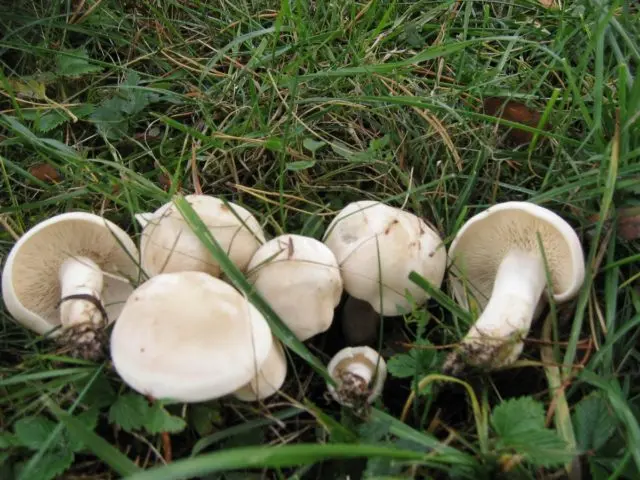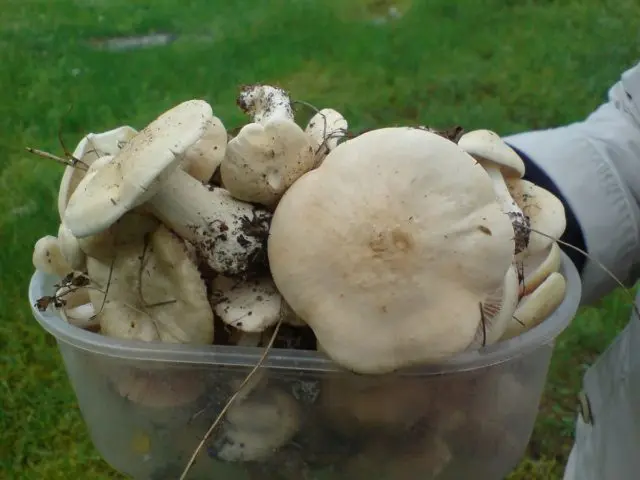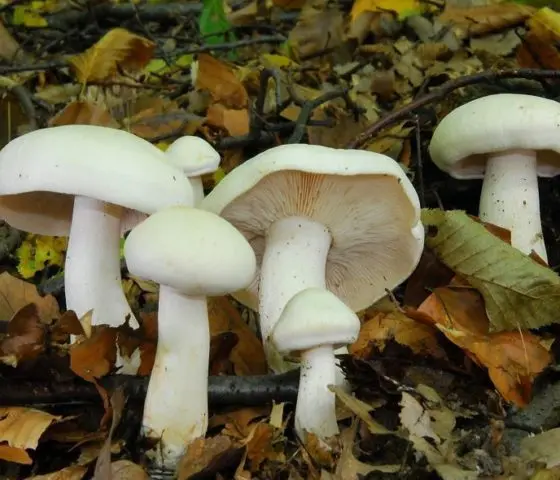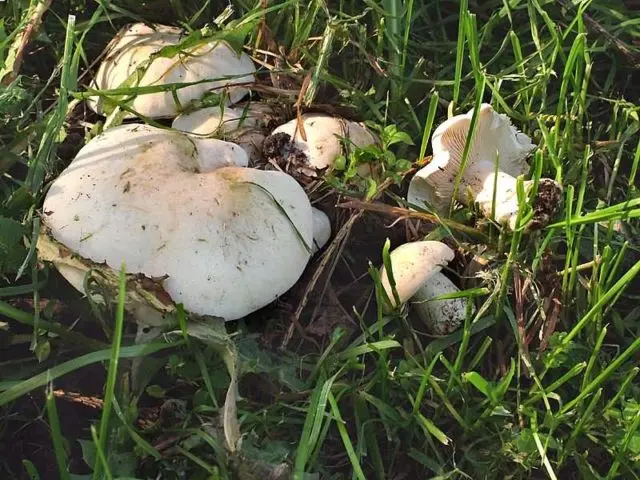Contents
Mushrooms such as rowings are found everywhere, almost throughout Our Country. Among them you can find both edible and poisonous representatives, which every mushroom picker should know about. A visual photo and description of the May row will allow you not to make a mistake during the “silent hunt” and diversify the spring diet with the first fragrant and tasty mushrooms, which are also very useful and have a lot of medicinal properties.
Where the May rows grow

The first spring mushroom grows in the western part of the country, in the Urals and the Far East, in Siberia, preferring to settle in mixed forests, parks and groves, along the edges of country roads. You can also meet him in the city – on lawns or flower beds, among flowers and herbaceous perennials, as well as in private gardens. The places of growth of the May row are sunny and open – pastures, meadows, sparse thickets of shrubs. She prefers sandy soil in birch and pine groves, choosing loose grassy bedding for herself. Active fruiting time falls on the end of spring-beginning of summer. In September, rows can be found in the same places where they grew in spring, but in small quantities. Row is also growing in all European countries. Often it can be found in places where morels and lines grow.
What do May rows look like?

Ryadovka May (other names – May mushroom, May calocybe, Calocybe gambosa) – agaric mushroom, which is characterized by a white color with a creamy tint, a fleshy hat and a dense cylindrical or club-shaped leg.
The diameter of the cap is from 5 to 12 cm, its shape is flattened or convex-prostrate, with uneven, as if cracked edges. With age, the cap acquires a yellow-ocher color, however, the plates in both old and young specimens have a light, whitish-cream color. At the same time, in overgrown mushrooms, the plates become thinner and become more frequent. In some fruiting bodies, the cap is bent during growth, which is associated with the biological features of the structure.
A shortened, dense stem does not grow more than 9 cm in height, expanding downwards. Its maximum thickness is 3,5 cm. The color of the stem is white with a yellowish tint, turning into ocher yellow closer to the base. The pulp of the May row is dense and fleshy, white in color, when cut it exudes a strong, pleasant aroma of flour. The taste is also floury, fresh. On the cut, the flesh does not change color. In their appearance, representatives of this species are somewhat reminiscent of champignons. However, a detailed description and photo of mushrooms makes it easy to distinguish the May row from the rest of the representatives of the mushroom kingdom.
Is it possible to eat May rows
May rows belong to edible mushrooms of the 4th category with gastronomic taste qualities. It is this species that is considered the most delicious among the representatives of the Ryadovka family. In addition, fruiting bodies contain many substances useful for the human body in optimal quantities, which is not typical for other varieties of mushrooms.
May row taste
The May row, which in European countries is called the St. George mushroom, has the taste and aroma of fresh flour with pleasant notes of cucumber. In its raw form, it is not eaten, but it is perfect for winter preparations and the preparation of various culinary dishes. Best of all, rowing shows its taste properties in a fried form. Pickled and salted fruit bodies also reveal their taste well. However, true gourmets use them in the preparation of soups, sauces, broths. For winter use, they are dried and frozen.
Benefits and harm to the body

Culinary dishes from the May row are not only tasty, but also extremely beneficial for the human body, because the main product has a lot of medicinal properties. Scientific studies have proven that calocybes are capable of:
- remove toxins and toxins from the body;
- stimulate the recovery of liver cells;
- normalize the tone of the stomach and intestines;
- boost immunity.
In their composition, they contain vitamins A, C, PP, B, various trace elements, and most importantly, enzymes, from which antibiotics are obtained in the medical industry to destroy tubercle bacilli. Due to the chemical composition of the rows have unique properties:
- antibacterial;
- antiviral;
- anti-inflammatory;
- antioxidant.
Mushrooms contain a minimum amount of calories and are distinguished by a balanced composition, which allows them to be widely used for dietary and vegetarian nutrition. In their composition, they are close to such a valuable product as beef liver and successfully replace meat.
In official medicine, it is recommended to eat the May row for those who suffer from:
- nervous disorders;
- diabetes;
- hypertension;
- oncological diseases;
- disorders of the genitourinary system;
- osteoporosis;
- rheumatism;
- arrhythmia and other cardiovascular diseases.
White May row helps prevent colds. If the product is regularly included in the weekly menu for three months, then infection can be completely avoided during the epidemic season. One of the most valuable properties of calocybe is the presence of anti-cancer components in the composition. Therefore, in China, a medicine against ovarian and cervical cancer is prepared from this species, and in Our Country pulp extracts are used to make medicines against diabetes.
Harm from the use of the May row has not been identified. However, like other mushrooms, it is a rather heavy food that is not recommended to be abused. Dishes with calocybe are completely contraindicated in gastritis with low acidity, pancreatitis and chronic diseases of the gastrointestinal organs in the stage of their exacerbation.
How to distinguish the May row
The May ryadovka, which grows in the country or in the garden, is similar in appearance to the white variety, the hat of which in young specimens is rounded-convex, and becomes flat with age. Poisonous white rowing has a pungent taste and a sharp, unpleasant odor. It grows from August to the end of October.

The smelly row is inedible, capable of causing hallucinations, therefore it is not eaten. The fruit body has a compacted pulp and a convex white cap. Emits a pungent smell of lighting gas. The variety bears fruit in autumn, in September-October. On the territory of Our Country, it grows only in the Amur region, but in Europe it is found everywhere.

As mentioned above, during the spring harvest, it is impossible to confuse the May mushroom with other members of the family, since they all bear fruit in the fall. However, the May row sometimes appears in September, continuing its growing season. During the autumn mushroom hunting, it is worth showing maximum attention. The main differences between inedible and poisonous rows are an unpleasant, pungent odor and pungent taste. Their hats eventually become flat, which is not typical for the May calocybe.
Collection rules
May rows are harvested in spring and early summer, in dry weather. Choose young and fairly mature specimens, cutting off with a sharp knife at the base. Unlike autumn representatives, May mushrooms do not accumulate toxins in themselves, so even adult fruiting bodies can be safely used as food. The collection time coincides with the active fruiting of morels and lines, which allows mushroom pickers to return home from the forest with a rich harvest. Since the variety grows in the spring and summer, when most of the mushrooms have not yet come into fruition, it is impossible to confuse it with similar species. It is not difficult to find the May row, mushrooms grow in large groups, in dense rows and “witch” circles, as shown in the photo, and if the search is successful, then the basket will quickly fill with dense, fragrant fruiting bodies.

How much to cook the May row
The collected mushrooms are first sorted out, cleaned of debris and washed thoroughly. Soak for 2 hours to remove residual dirt. Before you start cooking culinary dishes from the May row, the raw materials must be properly prepared. In order for the taste qualities of the product to be fully revealed, the fruiting bodies are subjected to a preliminary complex heat treatment.
Algorithm of actions:
- Boil mushrooms for 10 minutes. in plenty of water with the addition of table vinegar.
- The liquid is changed by filling the calocybe with fresh water, also adding vinegar.
- Boil for 20 minutes, then put a head of peeled onion and boil for another 10 minutes.
- They are thrown into a colander, the broth is poured out, the rows are prepared according to the recipe used.
How to cook May row
Recipes for dishes from the May row are varied. Mushrooms are great for pickling, stewing, frying, pickling. Fruiting bodies pre-prepared in the above way are laid out in a heated frying pan with butter, salted, peppered, onion rings are added. According to many gourmets, this is the most savory dish from calocybe. This species also reveals its original taste and forest, unusually pleasant aroma in soups and sauces with the addition of sour cream and butter.
The following recipe for marinating the May row will allow you to prepare it for winter storage.
The algorithm is as follows:
- Pre-boiled fruiting bodies are placed in an enamel pan, poured with water.
- For 1 kg of mushrooms, take 30 g of salt and sugar, 2 bay leaves, several cloves and black peppercorns. Everything is sent to the mushroom mass.
- After boiling, cook for 5 minutes. and add 40 ml of vinegar.
- The mixture is distributed in sterilized jars, peeled garlic cloves are added and on top – 1 – 2 tbsp. l. vegetable oil.
- Banks cork, store in a cool, dark place.
Salted rows are prepared in a slightly different way:
- Prepared fruiting bodies are placed in an enamel pan in layers, each is sprinkled with salt, peppercorns, horseradish leaves. Add peeled garlic cloves.
- They cover with clean gauze and put oppression.
- Cleaned in a cool dark place for 40 days.
- Salty rows are transferred to clean jars and covered with plastic lids.
- Sent to the refrigerator for storage.
It is also possible to prepare a calocybe for future use by the drying method, for which the fruiting bodies are strung on a thread and hung in a well-ventilated, sunny and open place. The drying process lasts 40 days.
In addition, May rows, previously boiled in salted water, can be placed in the freezer and subsequently any mushroom dishes can be prepared from them.
Conclusion
A photo and description of the May row will not allow you to confuse it with other representatives of the mushroom family and will make it possible to harvest a large crop during a “silent” hunt. The first spring mushrooms will not only significantly diversify the table, but will also please with their excellent taste, bring invaluable benefits to the body, and make up for the lack of vitamins and minerals.









